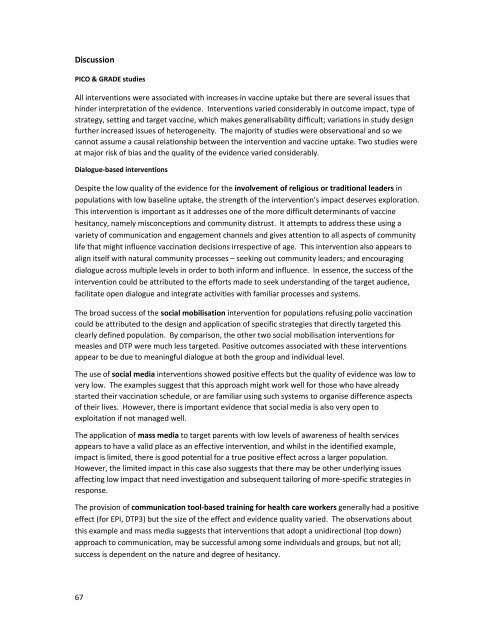2_SAGE_Appendicies_Background_final
2_SAGE_Appendicies_Background_final
2_SAGE_Appendicies_Background_final
You also want an ePaper? Increase the reach of your titles
YUMPU automatically turns print PDFs into web optimized ePapers that Google loves.
DiscussionPICO & GRADE studiesAll interventions were associated with increases in vaccine uptake but there are several issues thathinder interpretation of the evidence. Interventions varied considerably in outcome impact, type ofstrategy, setting and target vaccine, which makes generalisability difficult; variations in study designfurther increased issues of heterogeneity. The majority of studies were observational and so wecannot assume a causal relationship between the intervention and vaccine uptake. Two studies wereat major risk of bias and the quality of the evidence varied considerably.Dialogue-based interventionsDespite the low quality of the evidence for the involvement of religious or traditional leaders inpopulations with low baseline uptake, the strength of the intervention’s impact deserves exploration.This intervention is important as it addresses one of the more difficult determinants of vaccinehesitancy, namely misconceptions and community distrust. It attempts to address these using avariety of communication and engagement channels and gives attention to all aspects of communitylife that might influence vaccination decisions irrespective of age. This intervention also appears toalign itself with natural community processes – seeking out community leaders; and encouragingdialogue across multiple levels in order to both inform and influence. In essence, the success of theintervention could be attributed to the efforts made to seek understanding of the target audience,facilitate open dialogue and integrate activities with familiar processes and systems.The broad success of the social mobilisation intervention for populations refusing polio vaccinationcould be attributed to the design and application of specific strategies that directly targeted thisclearly defined population. By comparison, the other two social mobilisation interventions formeasles and DTP were much less targeted. Positive outcomes associated with these interventionsappear to be due to meaningful dialogue at both the group and individual level.The use of social media interventions showed positive effects but the quality of evidence was low tovery low. The examples suggest that this approach might work well for those who have alreadystarted their vaccination schedule, or are familiar using such systems to organise difference aspectsof their lives. However, there is important evidence that social media is also very open toexploitation if not managed well.The application of mass media to target parents with low levels of awareness of health servicesappears to have a valid place as an effective intervention, and whilst in the identified example,impact is limited, there is good potential for a true positive effect across a larger population.However, the limited impact in this case also suggests that there may be other underlying issuesaffecting low impact that need investigation and subsequent tailoring of more-specific strategies inresponse.The provision of communication tool-based training for health care workers generally had a positiveeffect (for EPI, DTP3) but the size of the effect and evidence quality varied. The observations aboutthis example and mass media suggests that interventions that adopt a unidirectional (top down)approach to communication, may be successful among some individuals and groups, but not all;success is dependent on the nature and degree of hesitancy.67



